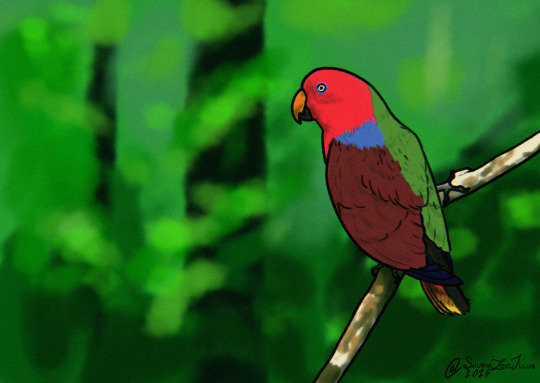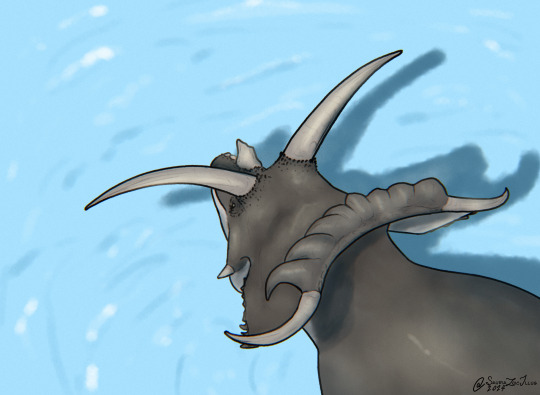#Eclectus infectus
Text
Paleostream 23/03/2024
WHOOPS GUESS WHO FORGOT TO POST YESTERDAY'S #Paleostream SKETCHES!!!
yesterday we drew Ectopistes migratorius (Passenger Pigeon), Eclectus infectus (Oceanic Eclectus), Kosmoceratops, and Otus frutuosoi (São Miguel scops owl)




#Paleostream#paleoart#paleontology#digital art#artists on tumblr#digital artwork#palaeoart#digital illustration#id in alt text#sciart#dinosaur#bird#birds#bird art#pigeon#owl#parrot#Ectopistes migratorius#Passenger Pigeon#Eclectus infectus#Oceanic Eclectus#Kosmoceratops#ceratopsian#Otus frutuosoi#Sao Miguel scops owl#paleobr#palaeobr
47 notes
·
View notes
Text




Results from the Flocking #Paleostream Passenger pigeon, Eclectus infectus, Kosmoceratops and Otus frutuosoi
409 notes
·
View notes
Text
Eclectus Parrot
Female Eclectus are the dominant gender. Consequently Females are somewhat louder and more moody than the males. The Eclectus parrots are observed in the northern parts of Australia, New Guinea, Soloman Island, Maluki Islands, and other outlying Pacific islands of eastern Indonesia. There's just one surviving species in the Eclectus genus, Eclectus roratus Nevertheless there were fossil records found found around the islands of Tonga and Vanuatu of some similar species, even though with bigger wings, Oceanic Eclectus Parrot Eclectus infectus, that is now extinct.
Eclectus Parrot
The Eclectus Parrot has developed into at least 10 subspecies, four of which can be found in the pet market. Currently six subspecies are described. Experts have not yet determined it a few of the others are authentic subspecies or potential hybrids. Differences in the subspecies are specific to the place they came from in the Pacific Islands and contain size, mind coloration, and brightness of plumage.
The females at each subspecies appear very alike, but the males vary widely in their mark. When they were attracted to the United States, several did not see differences from the coloring involving the subspecies and thus the Eclectus parrot was hybridized while filmed in captivity that has resulted in variations in coloring.
Eclectus Parrot details:-
The four Eclectus subspecies most commonly found in captivity and available in the pet marketplace are the Grand, the Vosmaeri, the Solomon Island and also the Red-sided: Subspecies: Eclectus roratus roratus, Called the Grand Eclectus
The Eclectus are quite plentiful in most of their native places, and in some places are considered insects. Yet because of the remote places some of those birds occupy, the number of all subspecies is undetermined. Much like the feathers of several fancy birds, the glowing feathers of these Eclectus are employed by natives for decoration.
Status
The Eclectus parrot Eclectus roratus was initially described by Muller in 1776. They are vividly colored birds with tight interlocking hair like feathers that produce a sleek glossy plumage that really looks like silk. Differences in the subspecies are unique to the place they came from at the Pacific Islands and include size, head coloration, and brightness of both plumages. What's striking about the Eclectus is your gap in coloring between the female and male. The man is a bright green and the feminine is a bright red.
Man Eclectus
The man Eclectus is brilliant green on top, has yellowish-green wing coverts, also has red patches in the breast and under the wings. The tail feathers are almost black with yellow tips. The top beak is a coral yellowish with a yellowish tip and the lower mandible is black. The iris is a dark orange. To keep the Eclectus wholesome, the veggies and green meals are essential. Dry seed is notably deficient in vitamin A that is the reason why they need additions to some seed based diet.
Their digestive tract is accommodated to a fibrous diet, which is provided by the fruits and vegetables. If deprived of a fibrous diet, then they might create Candidiasis. (see ailments under). Eclectus are also more prone to becoming fat, yet another reason why they should be encouraged to eat more veggies and less fatty seed. A cuttle bone or even a calcium block is a fantastic supply of calcium.
Female Eclectus
The female Eclectus includes a rich red on the chest and breast feeding whiles the back and wing feathers have a tendency to darker reddish. The stomach and the nape of their neck are a dull purple into some gloomy and the tail is tipped with crimson. Their beak is black. The iris of the female is a yellowish colour and they have a blue ring around the eye. (All youthful Eclectus have brown irises.) .
From the wild the Eclectus parrots eats seeds, legumes, berries, nuts, fruits, foliage buds, blossoms, and nectar. At your home, new water and food must be offered daily. Foods to the pet bird may include a ready made big hookbill seed mix enhanced with vitamins. Eclectus must also have their diet supplemented with all sorts of fruits and vegetables.
Description
Fresh fruits and veggies you can include include green beans, banana, young dandelion greens, sweet corn, beet greens, broccoli, carrots, unsprayed lettuce, chickweed, dandelions, eggplant, green peppers, sorrel, spinach leaves, tomatoes and zucchini. Fruits which you're able to include include, apples, pears, pears, apricots, bananas, pears, plums, raisons, and most other fruits. Avocado and chocolate are believed to be poisonous for birds and salt and sugar should be avoided.
Housing
Most parrots like and occasional shower or bathtub. A bath pan or ceramic dish 12"-14" (30-35 cm) could be set on the bottom of the cage or mounted at about 39" (1m) above the ground at an aviary. The wings must be kept trim if you want to discourage flight and also to protect against the loss of your pet through an open window or door. The beak and claws need to be trimmed if they aren't worn down from climbing and chewing.
A crate best suited to adequately house an Eclectus parrot would be between 4 feet to 6 feet (100-150 cm) high and have a floor area of two feet by 3 feet (60 x 100 cm). This dimension will provide room for lots of movement as well as area for perches, food meals and an assortment of playthings. Perches must be organic timber ranging in size from 2 -- 4 inches in diameter. Various sized fruit tree branches work very well.
Maintenance
An outside or breeding aviary needs to have a secure shelter that could be warmed and cooled if needed. It should be no greater than 4 feet by 6 feet with a floor area of at least 3 feet by 3 ft (1 m x 1 m), be off the floor by 4 ft, and also have an attached airport cage. A climbing branch and a bird bath are fine additions also.
Weekly you ought to wash all the perches and dirty toys, and the ground should be washed about every other week. A complete hosing down and disinfecting of an aviary needs to be done yearly, replacing anything that needs to be freshened, including old dishes, toys and perches.
0 notes